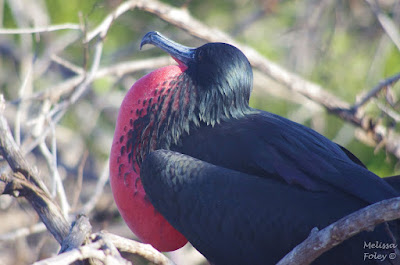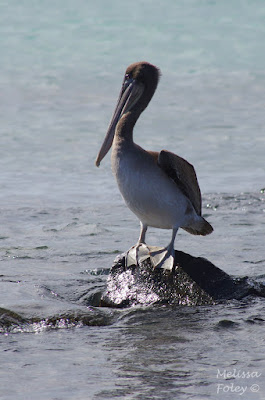While the Galápagos gets a lot of attention for its
tortoises and finches, there are so many other birds that make the islands
their home. We like birds quite a lot, but I don’t think we count as legit
“birders.” We have binoculars; we make lists; we have bird books for most of
the places we have travelled…but we do not plan our trips around birds or get
up at crazy hours to see birds. The Galápagos may have been the easiest
birding we have ever done. Stepping on a bird was more of a concern than not getting a good look at it before it flew away.
In addition to the finches, there are a number of other birds that are endemic to the Galápagos...the only place on earth where they are found. They are all birds we are familiar with from mainland locales, but these species have been isolated from other populations to become their own distinct species. Some of our favorites that gave us some up close and personal time included the Galápagos dove, hawk, mockingbird, and penguin.
Galápagos dove
Galápagos hawk
it was a bit of a soggy day so this guy spent a lot of
time preening his feathers...five feet away from us.
time preening his feathers...five feet away from us.
this mockingbird was on Española Island. like the tortoises
and lava lizards i mentioned in a previous post, the
mockingbirds also differ between islands.
and lava lizards i mentioned in a previous post, the
mockingbirds also differ between islands.
Galápagos penguin
this is the only species of penguin that lives north of the equator.
And then there were the boobies. Seriously, why were they not called footies?! We saw three species on this trip. The red-footed boobies come in two color morphs - white and brown.
white color morph on his/her nest in a tree
The red-footed boobies are the only species in the Galápagos that nest in trees (on San Cristóbal Island). Given their webbed feet, it really is not a wonder that other boobies do not nest in trees.
The blue-footed boobies--one of my most anticipated bird sightings--live on most of the islands. I love their feet best…such an amazing color. I also love their faces. Depending on the angle, their expression changes markedly.
The chicks are awkwardly adorable and can be quite feisty, especially if a frigate bird comes looking for a meal. Or when they are looking for a meal from a parent...
Wheels up!
The third species of booby we saw was the Nazca booby (recently split from the masked booby) on Española Island. These birds are stunningly white. Males and females take turns incubating the eggs and raising the chicks. Masked boobies often have two or three eggs in a clutch, but usually only one chick survives. The parents let the chicks duke it out for survival...talk about sibling rivalry!
We saw flamingos on Floreana Island. Flamingos are such interesting birds that rely on brine shrimp for their food and color. We even say babies...they are the grey puff balls on the reef.
Just when you thought you had seen all of the crazy things birds can do, you get up close and personal with some frigate birds. These birds are amazing flyers. Researchers just discovered that they can stay in the air for WEEKS. And up to 12,000 feet above the surface of the earth. They soar over the oceans but cannot land on it because their feathers are not waterproof, so they have developed incredible soaring abilities and only rest on land. These birds sailed over our boat for hours without a single wing flap. By the time we made landfall, we had seventeen birds flying in formation over our bow.


Male frigate birds win a prize for male showiness. Sexual selection is strong in these birds! During the breeding season, they inflate these ridiculous red pouches on their necks like a balloon to attract females. Once they mate, the pouch starts to deflate. After the pouch is completely deflated, the black feathers on the edges of the pouch cross over and tuck the pouch away for another year. Incredibly enough, the males can fly with their pouches inflated, but they look SO ridiculous. This guys pouch has already deflated some if you can believe that!
The dark side of these guys is that they are thieves and murderers. They harass other birds until they give up their hard-won fish snacks and kill other seabird chicks.

Frigate birds are also tree nesters and make platform nests out of sticks cemented together with their poo. And also have adorably awkward looking chicks.
There was a whole cast of additional birds too.
Swallow-tailed gulls with their scissor tail that is reminiscent of a swallow.
Three types of herons -
lava heron (endemic)
yellow-crowned night heron
small great blue heron
One of my favorite birds that we would often see off the stern of the boat is Elliot's petral. They look like little fairies dancing on the surface of the water. So graceful and lovely to watch.
Brown pelicans were fairly abundant on the islands, but we got quite a show from this one on Floreana Island as it played with rocks in the surf.
The biggest bird from our trip is another ocean-going bird that spends little time on land. This gentle giant is the waved albatross. Another bird with stunningly white plumage. While sitting or standing on the rocks or soaring through the air, they look so elegant...
and then they try to walk...
Sometimes we just found homes but no birds... (cactus finch nest)































